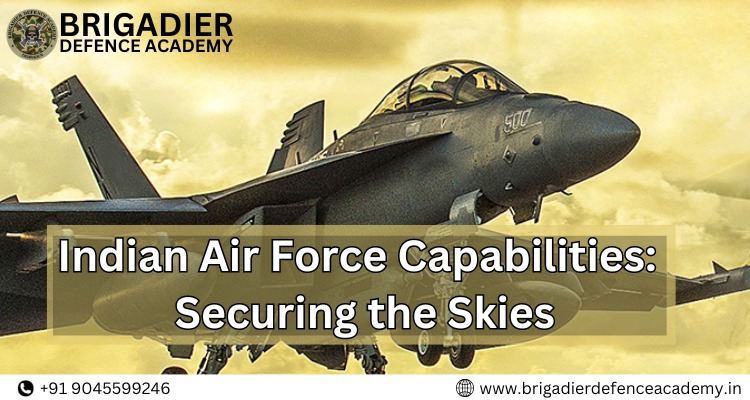Introduction of Indian Air Force
The Indian Air Force (IAF) is a cornerstone of India’s national defense, responsible for protecting its airspace and projecting power when necessary. With a rich history and a wide range of capabilities, the IAF is a formidable force in South Asia. This article delves into the Indian Air Force’s capabilities, exploring its aircraft, air defense systems, training programs, and its role in safeguarding the nation.
Aerospace Arsenal
The Indian Air Force boasts an impressive and diverse fleet of aircraft, which are continuously modernized to meet evolving security challenges. Here are some of the key components of the IAF’s aerospace arsenal:
- Fighter Aircraft: The IAF’s fighter aircraft are the tip of the spear. Aircraft like the Sukhoi Su-30MKI, MiG-29, and Tejas provide India with air superiority capabilities. The Rafale, a modern multirole fighter, has significantly enhanced the IAF’s combat capabilities.
- Transport Aircraft: Transport aircraft like the C-17 Globemaster III and C-130J Super Hercules are vital for troop transport, logistics, and humanitarian missions. These aircraft enable rapid deployment and mobility.
- Helicopters: The IAF operates a variety of helicopters, including the Mi-17 for troop transport and the Apache and Chinook for attack and heavy lift capabilities.
- Airborne Early Warning and Control (AEW&C) Aircraft: The Phalcon and Netra AEW&C systems provide crucial surveillance and control, enhancing situational awareness and early warning capabilities.
- Unmanned Aerial Vehicles (UAVs): The IAF employs UAVs for reconnaissance, surveillance, and target acquisition. UAVs like the Heron and Harop have expanded its intelligence, surveillance, and reconnaissance (ISR) capabilities.
- Combat Support Aircraft: Refueling tankers like the IL-78 enhance the IAF’s endurance and range, while AWACS (Airborne Warning and Control Systems) provide command and control capabilities.
- Trainer Aircraft: Training is essential, and aircraft like the Hawk and Kiran trainers play a vital role in pilot instruction.
Air Defense Systems
The Indian Air Force’s capabilities are not limited to aircraft alone; it also boasts an array of air defense systems designed to protect Indian airspace. These systems include:
- Surface-to-Air Missiles: Systems like the Akash and Spyder provide protection against aerial threats, including aircraft and missiles.
- Air Defense Artillery: Anti-aircraft guns and missile systems, such as the ZU-23 and the Strela, bolster the IAF’s air defense capabilities.
- Radar Systems: Advanced radar systems like the Swordfish and Rohini are vital for tracking and identifying incoming threats.
- Integrated Air Defense Networks: The IAF has established integrated air defense networks to ensure seamless coordination among various air defense elements.
Training and Human Resources
The Indian Air Force places great emphasis on training and the development of its personnel, recognizing that well-trained personnel are key to its capabilities. Here are some aspects of IAF training:
- Pilot Training: The National Defence Academy (NDA) and the Indian Air Force Academy (AFA) train pilots. After rigorous training, pilots can fly a range of aircraft, from fighter jets to transport planes.
- Technical Training: The IAF operates several technical training institutes to ensure that its personnel can maintain and repair the aircraft and equipment.
- Advanced Training: Ongoing training, exercises, and simulations help the IAF’s personnel to stay current and adapt to new technologies and tactics.
- Human Resources: The IAF recruits, retains, and develops a dedicated and skilled workforce. This includes not only pilots but also engineers, technicians, and support staff.
Role in National Defense
The Indian Air Force plays a multifaceted role in India’s national defense:
- Air Superiority: The IAF is primarily responsible for ensuring air superiority, meaning it can dominate the skies and deny enemy aircraft the freedom to operate.
- Aerial Strike Capability: It has the capacity to launch precision airstrikes against a variety of targets, from enemy airfields to strategic installations.
- Counterinsurgency and Border Patrol: The IAF is involved in counterinsurgency operations and plays a crucial role in patrolling India’s vast border regions.
- Humanitarian Assistance and Disaster Relief: The IAF’s transport aircraft and helicopters are often at the forefront of humanitarian and disaster relief efforts, both within India and abroad.
- Strategic Reach: The IAF can project power far beyond India’s borders, allowing the nation to exert influence and protect its interests in the region.
Challenges and Modernization
The Indian Air Force faces several challenges as it seeks to maintain and enhance its capabilities:
- Aging Aircraft: Many of the IAF’s aircraft are aging, and this creates maintenance challenges and limits their operational availability.
- Budget Constraints: Like the other branches of the armed forces, the IAF contends with budgetary limitations that affect its ability to acquire and maintain modern equipment.
- Technology Upgradation: Staying at the cutting edge of technology is vital in modern air warfare. Keeping aircraft and systems updated is a significant challenge.
- Personnel Shortages: The IAF often faces shortages of trained personnel, particularly pilots.
- Geopolitical Dynamics: India’s strategic position in South Asia means the IAF must be prepared for a range of potential threats, from traditional warfare to counterterrorism operations.
Modernization efforts are ongoing to address these challenges. The acquisition of the Rafale fighter aircraft, as well as plans for indigenously developed systems like the Tejas, are steps in this direction. Additionally, the IAF is investing in advanced air defense systems and electronic warfare capabilities.
Conclusion
The Indian Air Force is an integral component of India’s national defense, responsible for securing its airspace, projecting power, and responding to a wide range of security challenges. With a diverse fleet of aircraft, robust air defense systems, a commitment to training and human resource development, and a multifaceted role in national defense, the IAF stands ready to protect India’s interests and maintain peace and stability in the region. In a dynamic and evolving security landscape, the IAF’s capabilities continue to adapt and strengthen to meet the nation’s security needs.
NOTE: Click Here, for Sarkari Naukri Latest Jobs Online Form at Sarkari Results 2023







